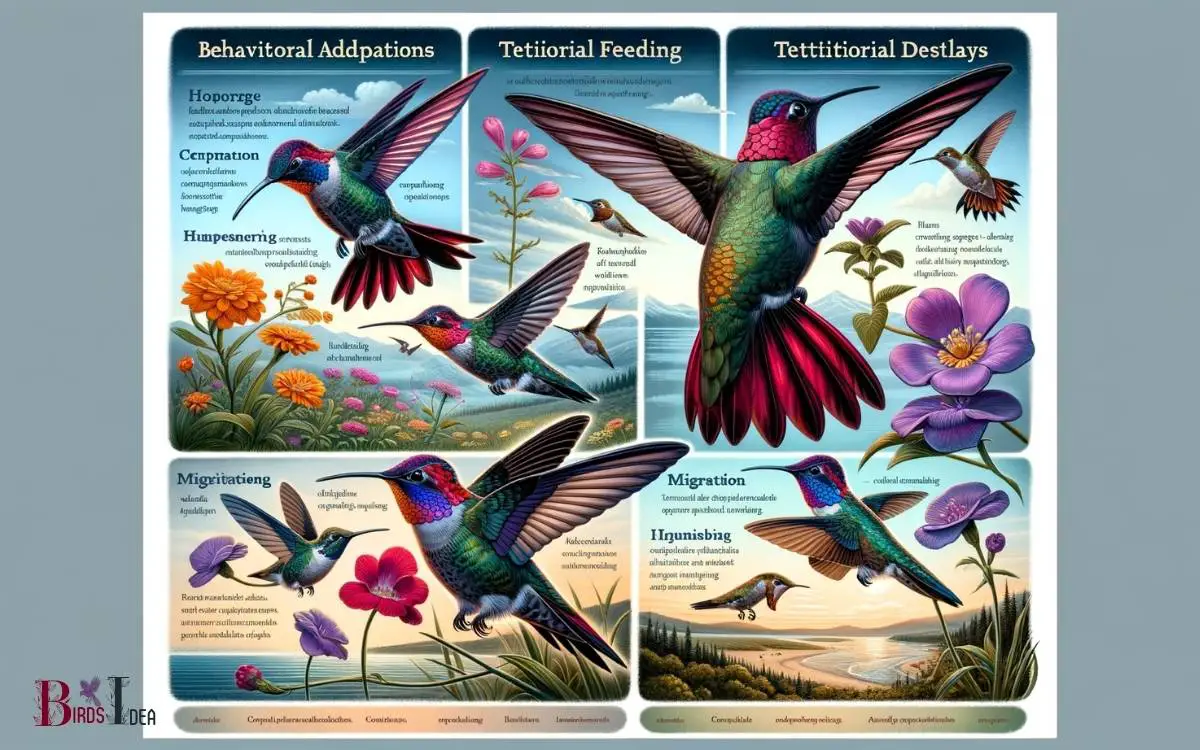Ruby Throated Hummingbird Behavioral Adaptations: Fidelity!
The Ruby-throated Hummingbird (Archilochus colubris) exhibits a range of behavioral adaptations that enhance its survival and reproductive success.
Key behaviors include expert aerial maneuvers, territorial defense, migration, flower fidelity, and energy conservation tactics.
These adaptations are crucial for the Ruby-throated Hummingbird’s lifestyle:
An example of their behavioral adaptation is during migration; to prepare, they will enter a hyperphagic state to build up fat reserves, enabling them to have enough energy for the journey.
Adapted for precision flying, the Ruby-throated Hummingbird’s acrobatics are essential for nectar foraging and evasion from predators.

Key Takeaway
Hovering Ability
The hovering ability of the Ruby Throated Hummingbird is a remarkable feat of aerial agility and precision.
This species achieves this through a unique combination of wing morphology and rapid wing beats, which can reach up to 80 beats per second.
The hummer’s wings are long and narrow, allowing them to rotate in a figure-eight pattern, generating lift on both the forward and backward strokes.
This motion enables the bird to remain suspended in mid-air, even in the face of strong winds.
The ability to hover with such control and stability allows the hummingbird to access nectar from flowers and catch small insects in flight, showcasing its exceptional adaptation to its foraging needs.
Feeding Techniques
The feeding techniques of the ruby-throated hummingbird involve intricate nectar extraction methods as well as the ability to hover and sip from flowers.
These techniques are essential for the bird’s survival, allowing it to efficiently extract nectar from a wide variety of flower species.
Understanding the nuances of these feeding behaviors provides valuable insight into the ecological role and evolutionary adaptations of this remarkable species.
Nectar Extraction Methods
When researching nectar extraction methods of the Ruby Throated Hummingbird, one can observe its unique feeding techniques that demonstrate remarkable adaptability.
These tiny birds have evolved specialized tools to extract nectar from flowers, including their long, slender bills and specialized grooved tongues.
The tongue of the Ruby Throated Hummingbird is particularly fascinating, as it can extend beyond the bill, allowing them to reach deep into flowers to access nectar.
This remarkable adaptation enables them to access nectar from a wide variety of flower shapes and sizes, showcasing their ability to thrive in diverse environments.
To emphasize the effectiveness of their feeding techniques, the following table illustrates the nectar extraction methods used by Ruby Throated Hummingbirds:
| Feeding Technique | Adaptation |
|---|---|
| Long, slender bills | Accessing nectar from deep flowers |
| Specialized grooved tongue | Efficient extraction of nectar from various flowers |
| Hovering and sipping | Consuming nectar without landing on the flower |
The next section will delve into the fascinating behavior of ‘hovering and sipping’ exhibited by these remarkable birds.
Hovering and Sipping
Demonstrating remarkable agility, Ruby Throated Hummingbirds employ hovering and sipping as their primary feeding techniques, allowing them to consume nectar without the need to land on the flower.
Hovering is achieved through rapid wing beats, which enable the bird to maintain a stationary position in mid-air.
This ability is supported by their unique shoulder joints that allow a full range of motion, contributing to their exceptional maneuverability.
As the hummingbird hovers in front of a flower, it uses its long, specialized bill to sip nectar with precision.
The bill’s tubular shape and the bird’s rapid tongue movements facilitate efficient nectar intake.
This feeding strategy enables them to access nectar from deep within flowers, giving them an advantage over other nectar-feeding birds.
Energy Conservation
The ruby-throated hummingbird exhibits remarkable energy conservation strategies. During the night, it enters a state of torpor, significantly lowering its metabolic rate to conserve energy.
Additionally, its unique ability to hover-feed for nectar allows for efficient energy expenditure while obtaining essential nutrients.
Torpor During Night
During the night, ruby-throated hummingbirds enter a state of torpor to conserve energy. Torpor is a physiological state characterized by decreased metabolic rate, heart rate, and body temperature.
By entering torpor at night, these tiny birds can conserve energy during periods of inactivity when their high metabolic rate would otherwise require frequent feeding.
During torpor, a hummingbird’s metabolic rate can decrease by as much as 95%, allowing them to conserve energy reserves until they are able to forage again at dawn.
This energy-saving adaptation is crucial for their survival, especially during periods of food scarcity or inclement weather.
The ability to enter torpor allows ruby-throated hummingbirds to thrive in diverse environments and cope with the challenges of their migratory lifestyle.
Hover-Feeding for Nectar
With a precise and efficient hovering technique, ruby-throated hummingbirds access nectar sources to conserve energy.
This unique feeding behavior allows them to extract nectar from flowers while maintaining a stationary position in the air.
As they hover in front of a flower, their rapid wingbeats create a subtle airflow that allows them to delicately position their long, slender bills into the flower’s corolla to access the nectar.
This hovering method minimizes the energy expended during feeding, as they do not need to perch or land to obtain nectar.
By conserving energy through this specialized feeding behavior, ruby-throated hummingbirds can efficiently fuel their high metabolic rates, essential for their active lifestyle.
This adaptation enables them to sustain their energy levels for other crucial activities such as nesting behavior, which plays a vital role in their reproductive success.
Nesting Behavior
Nesting behavior in the ruby-throated hummingbird involves the selection of strategic nesting locations and the construction of small, cup-shaped nests using plant fibers and spider silk.
These nests are typically built in the forked branches of trees, where the female hummingbird meticulously weaves together various materials to create a secure and camouflaged environment for her eggs.
The hummingbird’s nesting behavior is characterized by the following:
- Selection of concealed locations such as dense foliage or overhanging branches to protect the nest from predators.
- Use of soft plant fibers, moss, and lichens for the construction of the nest, providing insulation and camouflage.
- Incorporation of spider silk to bind the nest materials together, allowing for expansion as the chicks grow.
This intricate nesting behavior reflects the hummingbird’s adaptation to ensure the survival of its offspring in the face of environmental challenges.
Migration Patterns
The ruby-throated hummingbird’s migration patterns are characterized by a remarkable journey spanning thousands of miles.
These tiny birds, weighing only a few grams, undertake one of the longest migratory journeys of any bird species.
In spring, they embark on a non-stop 500-mile flight across the Gulf of Mexico from the Yucatan Peninsula to the Eastern United States and Canada.
This journey requires an incredible amount of energy, and the hummingbirds double their body weight to prepare for this feat. Their migration is guided by instinct and environmental cues, such as daylight length and magnetic fields.
Once they reach their breeding grounds, they establish territories and begin nesting. In fall, they make the return journey, often following a different route along the Gulf Coast.
The migration of the ruby-throated hummingbird is a testament to their remarkable endurance and navigational abilities.
Territorial Defense
During the breeding season, ruby-throated hummingbirds vigorously defend their territories from intruders. This territorial defense is crucial for ensuring access to food resources and suitable nesting sites.
The following behaviors are commonly observed during territorial defense:
- Aggressive chasing: Hummingbirds will aggressively chase and confront intruders that enter their territory, engaging in high-speed aerial pursuits to drive them away.
- Vocal displays: They emit sharp, chattering calls to assert their ownership of the territory and deter intruders.
- Perch guarding: Hummingbirds often perch in prominent locations within their territory, keeping a vigilant watch for potential intruders and swiftly intercepting any perceived threats.
These territorial defense strategies are essential for maintaining the integrity of their breeding grounds and ensuring successful reproduction.
Courtship Rituals
In the context of their territorial defense, ruby-throated hummingbirds exhibit distinctive courtship rituals as part of their breeding behavior. During courtship, male hummingbirds perform elaborate aerial displays to attract females.
These displays involve flying in large, repeated oval patterns, creating a distinctive humming sound with their wings. The male will also ascend to great heights before diving steeply and producing a loud chirping sound.
Once the female is attracted, the male will continue to display by flying back and forth in front of her while spreading and closing his tail feathers.
This behavior allows the female to closely observe the male’s iridescent throat feathers, a key aspect of his attractiveness.
The table below summarizes the key courtship behaviors of ruby-throated hummingbirds.
| Courtship Behavior | Description |
|---|---|
| Aerial displays | Elaborate flying patterns and wing sounds |
| Diving and chirping | Ascending and diving steeply with loud chirping |
| Tail feather display | Spreading and closing of tail feathers in front of the female |
| Display of iridescent throat feathers | Male flaunts its attractive throat feathers to the female |
Thermoregulation
Efficiently, ruby-throated hummingbirds regulate their body temperature through a process called thermoregulation. This is crucial for their survival, especially during cold nights or in cooler climates.
Here’s how they achieve this:
- Shivering: Hummingbirds can shiver to generate heat, which helps maintain their internal temperature.
- Torpor: During the night or when resources are scarce, these birds can enter a state of torpor, slowing down their metabolic rate and conserving energy.
- Sunning: Hummingbirds often engage in sunning behavior, where they perch in the morning sunlight to absorb warmth and raise their body temperature.
These mechanisms enable them to adapt to varying environmental conditions, ensuring their physiological functions remain optimal. Such adaptations are essential for their survival and reproductive success.
Vocal Communication
The vocal communication of the ruby-throated hummingbird plays a significant role in their social interactions and territorial defense.
These birds produce various vocalizations, including calls and songs, to convey messages to each other.
The calls are short, sharp chips used in aggressive interactions or to signal alarm. The songs, produced by the males during courtship displays and territorial defense, are complex and consist of repeated high-pitched notes.
Observational studies have shown that the frequency and intensity of vocalizations change in response to different social contexts, such as mating rituals or aggressive encounters.
Additionally, vocal communication helps establish and maintain the hummingbirds’ territories, serving as a means to warn intruders and attract potential mates.
Overall, vocal communication is an essential tool for the ruby-throated hummingbird in navigating their social and ecological environment.
Conclusion
The ruby-throated hummingbird exhibits a remarkable array of behavioral adaptations that enable it to thrive in its environment.
From its incredible hovering ability and feeding techniques to its energy conservation and migration patterns, this tiny bird has developed a wide range of strategies for survival.
Through territorial defense, courtship rituals, and vocal communication, the hummingbird also demonstrates complex social behaviors.
As the saying goes, “adapt or perish,” and the ruby-throated hummingbird has certainly mastered the art of adaptation.






